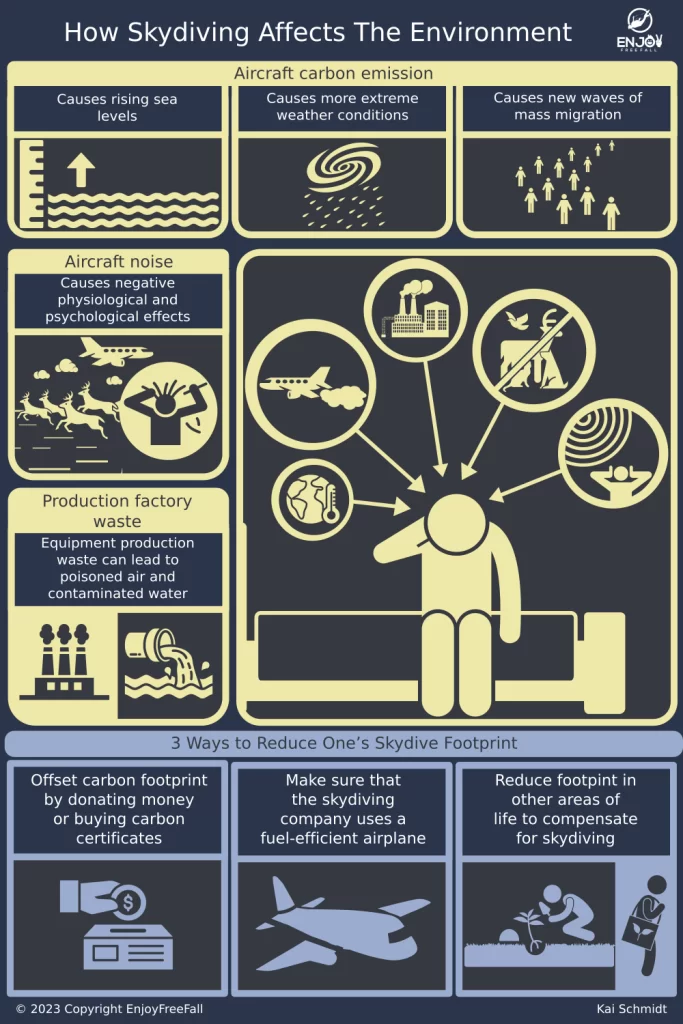
Every skydiver has had a conversation with a friend or colleague about the environmental effects of skydiving. It is often difficult to stay objective in such a discussion and to put the environmental impacts into perspective. Here is how skydiving affects the environment.
Skydiving has several negative impacts on the environment including greenhouse gas emission and noise pollution for birds and other animals. In addition, the production of skydiving equipment and aircrafts damage the environment.
In order to get the full picture, one also needs to compare these impacts with those of other activities. I also outlined three strategies to skydive regularly and being environmentally friendly at the same time.
The Effects of Carbon Emissions From Skydiving on the Environment
How Much Carbon Is Emitted per Skydive?
Depending on the aircraft model the average carbon emission per skydiver per jump is between 24 – 60 lbs (11 – 27 kg). If a skydiver performs 100 jumps per year (that are 4 jumps every second weekend) he would be responsible for carbon emissions between 2,447 – 6,000 lbs (1,110 – 2,722 kg).
These carbon emissions are equivalent to driving a car between 6,000 – 14,600 miles per year (9,500 – 23,500 km). To put it into further perspective, the average carbon production per person in the US is around 33,000 lbs (15 tons) per year. This means that skydivers increase their carbon emissions between 7 – 18% per year.
This is quite a significant increase – specifically if one considers that we need to reduce carbon emissions to 3 tons per person per year to stop climate change. If every other country were to produce the same amount of carbon as the average western country we would need four earths to live sustainably.
What Impact Does Carbon Emission Have?
If you are very familiar with the effects of carbon emissions you can skip this section and directly resume with the comparison of skydiving emissions with other activities.
Carbon emissions are known to be the strongest contributor to global warming due to the greenhouse effect. The greenhouse effect describes the phenomena that more solar radiation stays within the earth’s atmosphere because greenhouse gases reduce the earth’s reflection of sunlight to space. With a higher concentration of greenhouse gases in the atmosphere, the atmosphere absorbs more solar radiation and therefore heats up faster than it releases heat to space.
If you are interested in knowing more about how the greenhouse effect works, you can find more information in this article written by NASA.
Rising sea levels – Due to increased temperatures, the sea level is expected to rise by 1 – 8 feet by 2100 – depending on the speed of temperature increase. Increases in sea levels are caused by melting glaciers and polar ice caps that currently store around 2.1% of the earth’s water.
While this might not sound like a lot, rising sea levels will have drastic impacts on regions and countries with coastlines. For example, a rise of 2 feet means that Bangladesh will lose 11% of its landmass and 15 million people will lose their homes. A 6 feet increase means that the Netherlands will be completely flooded. Rising effects will also have visible effects on many cities and states in the U.S. If global warming continues at the current rate, Florida is expected to be underwater by 2100.
More extreme weather conditions – Another effect that is already observable for many people is that we are exposed to extreme weather conditions and changes much more often. The intensity and frequencies of hurricanes have been increasing since the 1980s. In addition, the number of droughts and crop failures rose significantly and undermined the basis of existence for many people.
While developed nations such as the US have the capabilities to cope with these changes, many developing countries do not have the resources to do so. This will lead to waves of mass migration – which will affect the US eventually as well.
New waves of mass migration – As the basis of existence will be deprived for many people, new waves of mass migration will occur. Forecasts from the World Bank and the International Organization for Migration suggest that there will be between 140 – 500m climate refugees by 2050. Although much of this immigration will happen within nations, specifically developing countries will have difficulties dealing with it.
Eventually, the US will also be affected by these movements – either directly through incoming refugee waves or indirectly through economic and political changes.
Comparing the Carbon Emission of Skydiving With Other Activities
Wait, all this is gonna happen because I skydive? Obviously not. While skydiving is one activity that emits a lot of carbon into the air, other activities are equally pollutive.
I included these comparisons here in order to put skydiving into perspective and not to justify its pollution. It helps to evaluate whether one still wants to skydive or not.
These comparisons are also quite practical when someone argues how bad skydiving is but then takes his car everywhere, flies frequently, or eats tons of meat at the same time. You can then hold the mirror up to the other person and unmask his hypocritical behavior.
| Activity | Av. Emission (in tons CO²) | Number of Skydives |
| 50 Skydives | 0.95 t | 50 |
| Average Car Emission in the United States | 4.60 t | 242 |
| Return Flight from NYC to SF | 1.15 t | 61 |
| Return Flight from NYC to London | 1.63 t | 86 |
| Building a Two-Bed Cottage | 80.00 t | 4,211 |
| Meat Diet | 3.30 t | 174 |
| Vegetarian Diet | 1.70 t | 89 |
| 50 Days of Skiing (excluding Journey to Destination) | 1.00 t | 53 |
As you can see, skydiving has high pollution rates. However, if you compare it to the average car emission level, skydiving emission rates are much lower.
If you were able to substitute your fuel car with an electric car or with public transportation, you would make up for 242 skydiving jumps – something that takes you 2-5 years to perform. Reducing your meat consumption can also help to make up for skydiving and bring down your carbon footprint.
What Effects Does the Noise Have on the Fauna and Residents Around the Dropzone?
Besides the negative carbon footprint, skydiving also affects the fauna around the dropzone due to increased noise levels. The noise of airplanes is known to have negative health impacts on animals and humans alike.
Humans that are constantly exposed to aircraft noises can be physiologically and psychologically impaired. The physiological impacts can be both long-term and short-term. As a long-term negative impact, people can reduce some of their hearing abilities by being constantly exposed to noise.
In addition, studies suggest that constant noise increases blood pressure and stress levels temporarily but is resolved after the noise has silenced. Negative psychological health effects include reduced sleep quality and high annoyance levels.
Aircraft noise has similar effects on animals as on humans. Aircraft noise is known to increase stress levels for wildlife around the dropzone. It can also interfere with the breeding cycles of birds and therefore reduce reproduction rates.
However, most of the studies indicate that the effects are only short-term and that hormones and stress levels reverse to the normal level after some time. This indicates that wildlife gets used to the noise and at some point is not damaged by it anymore.
In general, there are many regulations in place about where airports and dropzones can be built. Due to these regulations, the noise effects are not as severe as they could be.
How Does the Equipment Production Affect the Environment?
Another factor that many people often forget about is the production of skydiving gear and the necessary airplanes. Production negatively impacts the environment because of carbon emission, the use of rare earth and metals, as well as a lack of recycling.
Although many airplanes are produced in Western countries such as the US or in European countries where environmental regulation prevents pollution, the material is often mined and enforced in countries without or low regulations such as Russia or China. It is not uncommon that wastewater is redirected into rivers and thereby poison the animals and plants around it.
In addition, transporting these materials across the globe adds to carbon emission. One of the problems with global supply chains is that so-called externalities are not included in the buying price of the material.
For example, a piece of metal might cost $500 when produced in the US and only $400 when produced in China. However, the environmental damage from the production in China and its shipment to the US might be equivalent to $150. Although the overall costs of the Chinese metal would be $550 and therefore $50 higher than in the US, companies only pay the $400 and therefore will buy the Chinese material.
Besides the airplanes, skydiving gear can negatively impact the environment when not being recycled properly. Although the carbon footprint might be comparable with that of other sports clothes, the material is often highly specialized and is not biodegradable. If it is then disposed of in normal trash, it will not be recycled properly.
If you are interested in knowing more about what materials are used to produce skydiving jumpsuits and how these materials will impact the skydive, check out this article that I wrote about it.

Three Ways to Reduce One’s Skydive Footprint
In order to do one’s bit and to reduce one’s own footprint, there are different strategies that you can use. You might also want to leverage all strategies or none – depending on your preferences.
Offset Carbon Footprint by Donating Money or Buying Carbon Certificates
It might be quite surprising that offsetting one ton of carbon dioxide is not that expensive. The cost to offset one ton of carbon dioxide ranges between $3 and $15. That would mean that skydivers need to pay an extra of $0.04 – 0.41 per jump – a price that every skydiver can afford considering the other costs that are associated with skydiving. It also means that skydivers only need to pay an extra of $4 – 41 per year when they perform 100 jumps a year.
Carbon offsets are often done in developing countries as the price levels are much lower there ie. one can have much more impact with the money spent. One example is that NGOs provide better and more modern cookstoves to villages in rural Africa or South Asia. As a result, they need much less fuel to cook and thereby reduce the carbon emission.
Improved cookstokes also have social impacts beyond environmental impacts. Women need less time to cook with better equipment and therefore have more time to raise their children. They also can start side-businesses and generate an extra income for their families.
There are also other projects that provide more efficient generators or solar panels to rural areas. People therefore do not need to use fuel-inefficient and pollutive generators to create energy. Together with new energy storing technologies, renewable energies can also become more reliable which enables rural areas to operate fridges, to have access to the internet and to have more electricity. All this effects have proven to increase education levels in rural areas.
Another favorite way is to plant trees and to stop deforestation in developing countries. The Amazon rainforest, for example, absorbs 2 billion tons of carbon each year which is approximately 5% of annual global emission. Stopping the Amazon rainforest to be slashed-and-burnt by local farmers is an important pillar to stop climate change.
However, there is also an ongoing debate on carbon offsetting and whether it is as effective as stopping emitting carbon in the first place. If you are interested in knowing more about this debate, you can check this article from the Guardian. (It’s a little bit older but still relevant).
Make Sure That the Skydiving Company Uses a Fuel-Efficient Airplane
Specifically, because there is a lot of arguments about offsetting one’s carbon footprint, it is a good way to only jump at skydiving companies that operate modern airplanes. Modern ariplanes are not only more fuel-efficient but also have a higher capacity such that more people fit in.
Depending on the aircraft model, the carbon emission can be between 24 – 60 lbs. So if your company uses a new aircraft, it pollutes the environment 2.5 times less than the older models.
In addition, you can also only jump if the airplane has a high utilization rate. While many skydiving companies will not even take-off if there are too few passengers, you tell the skydiving company that you will only join if a certain utilization is reached. If every skydiver was to do this, it would increase the pressure on the skydiving companies to fill their utilization and to operate more efficient aircraft.
Reduce Footpint in Other Areas of Life to Compensate for Skydiving
The last way to make up for your increased carbon footprint is to be more environmental friendly in other areas. As already shown in the table above, driving a car produces 4.6 tons of carbon per year which is equivalent to 242 skydiving jumps per year.
If you are able to afford an electric car, you will become carbon neutral with your car and save a lot of carbon (assuming that you charge your car with energy from renewable sources).
If you have less budget, you can also reduce your meat consumption. You do not need to become a Vegetarian (I eat meat as well) but maybe you can start eating meat only 2-3 days per week.
Many people also say that the little things such as turning off the light regularly matter as well. I agree that it is good to do that but is much more effective to focus on avoiding big emissions. For example, building a new house emits around 80 tons of CO² into the atmosphere. This is what the average US citizen produces in 5.5 years. It is also equivalent to 4,211 skydiving jumps.
If you instead refurbish an existing house and make it more energy efficient, you will have a much greater effect. You can also put these arguments forward when some of your friends or colleagues judges your hobby.
All these negative effects aside, skydiving is a life-changing and wonderful sport which also showcases freedom and how beautiful our world is from up above the skies. If you want to get to know the 15 most mind-blowing places for wingsuits flying, make sure to check out my post about it.
In the end, everyone needs to decide for himself if he cares about climate change and what he wants to do himself to stop it. I personally enjoy skydiving too much as to be able to stop it. In order to still do my bit, I try to make up for it in other areas of my life and I donate money to reforestation.
With this is mind, enjoy your freefall!




